状语从句复习学教案
- 格式:doc
- 大小:58.00 KB
- 文档页数:2
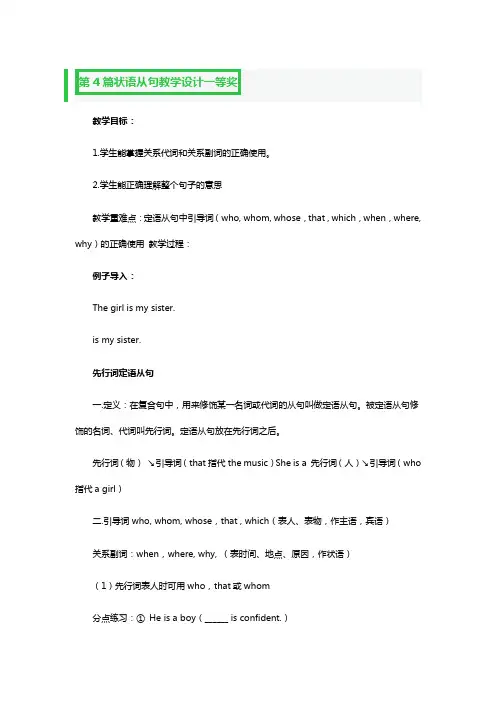
第4篇状语从句教学设计一等奖教学目标:1.学生能掌握关系代词和关系副词的正确使用。
2.学生能正确理解整个句子的意思教学重难点:定语从句中引导词(who, whom, whose,that , which,when,where, why)的正确使用教学过程:例子导入:The girl is my sister.is my sister.先行词定语从句一.定义:在复合句中,用来修饰某一名词或代词的从句叫做定语从句。
被定语从句修饰的名词、代词叫先行词。
定语从句放在先行词之后。
先行词(物)↘引导词(that指代the music)She is a 先行词(人)↘引导词(who 指代a girl)二.引导词who, whom, whose,that , which(表人、表物,作主语,宾语)关系副词:when,where, why, (表时间、地点、原因,作状语)(1)先行词表人时可用who,that或whom分点练习:①He is a boy(______ is confident.)主语②(介词提前)③He is the teacher ( ______ you are waiting for.)宾语归纳总结:当先行词是人:①引导词在句中作主语,引导词用who,that③引导词在从句中作宾语,引导词用who/whom小试牛刀:1.Is this the man with ______ you went to the zoo yesterday?A. whoB. whomC. which2.He is a man ( _______ we can learn).A. whomB. from whichC. from whomlearn from【2013广东湛江】25. —Look! That is the woman I met yesterday.—Oh? She’s my aunt.A. whatB. whoC. whereD. when【2013广东】45. The young lady ______ is interviewing Lin Zhixuan about the program I am a singer is from 21st Century Talent Net.A. whoB. whomC. whichD. whose(2)whose的使用名词A. whichB. whoseC. that引导词后面有名词(表所属)时,引导词用whose(3)先行词表物时,用that或whichthat与which的区别:that和which都可表物,一般可互换,但下列情况只用that1. I’m sure she has something ______ you can borrow.A. thatB. which⑴先行词为:that 2. I’ve read ⑵先行词被all, every, no, some, any, little, much 等修饰时4. This is the only book that belongs to him.⑷先行词被the only, the very, the same, the best, the last等修饰时6. There is a book on the desk belongs to Tom. 桌子上那本书是汤姆的⑹在7 Who is the girl ______ spoke to you just now?Which is the car _____ was made in China?A. thatB. whoC. which[7].当主句that巩固练习:Who is the man ______ I saw yesterday.小试牛刀:I like the music _______ he writes.A. /B. whoC. why D when只用which的情况:1.This is the house in ______ he lives.A. thatB. whichC. who1.先行词是物,且介词提前用whichThe school (______ my father works) looks very beautiful.(my father works in the school)A. whichB. in thatC. in which对比:Is this the man with ______ you went to the zoo yesterday?A. whoB. whomC. which先行词是人,且介词提前用_______.2.先行词(物)与引导词之间有逗号隔开(非限制性定语从句),用which 2.He lives in a house, _______ has many trees around it.A. thatB. whichC. who3.先行词为that, those时,用which3.What’在桌子底下的那些东西是什么?【2011广东】44. The first thing _____ my brother is going to do this afternoon is to write a letter.A. whichB. thatC. whyD. who【2011?广州】The story ______ I read the newspaper was about a common problem among teenagers.A. whoseB. whoC. thatD. where【2013安徽】49. I still remember the college and the teachers_____________I visited in London years ago.A. whatB. whoC. thatD. which(4)关系副词when, where,why的用法:先行词是一个表示时间的词如:time, hour, day, month, year时,其所对应的关系词如在定语从句中作时间状语(不充当从句的主语或宾语),则用关系副词when。

状语从句教案教师;张耀文状语从句不仅是初中英语学习的重点,而且也是每年中考必考的内容之一。
从笔者研读历年全国各地中考英语试题对状语从句的考查内容来看,命题主要集中在引导状语从句的连词、状语从句的时态等方面;从九大状语从句来看,同学们应将复习重点放在时间状语从句、条件状语从句、结果状语从句和比较状语从句这四种上。
核心知识一、对时间状语从句的考查1.要点:1)引导时间状语从句的连词有:while,when,as,as soon as,until,not...until,before,after,since,etc.要掌握每个连词的含义及其用法,还有它们之间的一些区别。
2)when,while,as的区别:①三者均可表示“当……的时候”,如果主句表示的是短暂的动作,而从句表示的是一段时间,三者可通用。
如:I met Kang Li as/when/while I was walking along the street.当我沿街散步时碰见了康丽。
②as和when都可与终止性动词连用,while只能与延续性动词连用。
如:It was snowing when we got to the airport.当我们到达机场时,天正下着雪。
(不能用while)③as强调主句与从句表示的动作同时发生;while强调主句表示的动作持续于while所指的整个时间内;when可指主、从句所述动作同时或先后发生。
如:He sang as he went along.他边走边唱。
Please write while I read.我读的时候,请写下来。
When he reached home,he had a little rest.回到家后,他休息了一会儿。
3)until和till在肯定句中表示“直到……为止”,主句要用延续性动词;在否定句中,表示“直到……才”,主句常用终止性动词,这时till和until可用before替换。
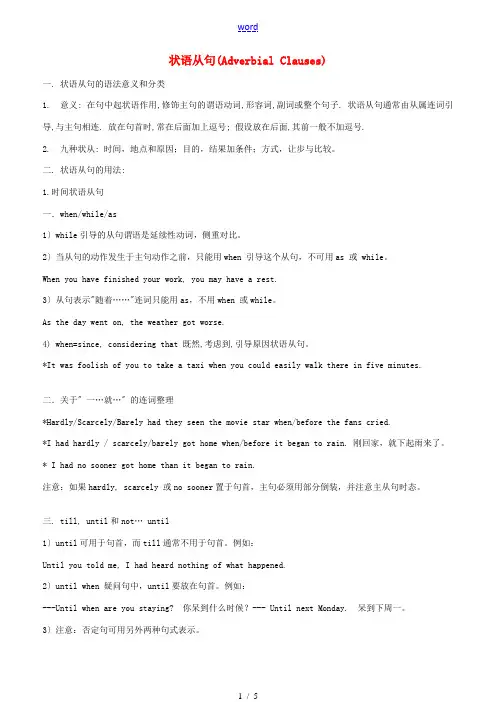
状语从句(Adverbial Clauses)一. 状语从句的语法意义和分类1. 意义: 在句中起状语作用,修饰主句的谓语动词,形容词,副词或整个句子. 状语从句通常由从属连词引导,与主句相连. 放在句首时,常在后面加上逗号; 假设放在后面,其前一般不加逗号.2. 九种状从: 时间,地点和原因;目的,结果加条件;方式,让步与比较。
二. 状语从句的用法:1.时间状语从句一.when/while/as1〕while引导的从句谓语是延续性动词,侧重对比。
2〕当从句的动作发生于主句动作之前,只能用when 引导这个从句,不可用as 或 while。
When you have finished your work, you may have a rest.3〕从句表示"随着……"连词只能用as,不用when 或while。
As the day went on, the weather got worse.4) when=since, considering that 既然,考虑到,引导原因状语从句。
*It was foolish of you to take a taxi when you could easily walk there in five minutes.二.关于〞一…就…〞的连词整理*Hardly/Scarcely/Barely had they seen the movie star when/before the fans cried.*I had hardly / scarcely/barely got home when/before it began to rain. 刚回家,就下起雨来了。
* I had no sooner got home than it began to rain.注意:如果hardly, scarcely 或no sooner置于句首,主句必须用部分倒装,并注意主从句时态。
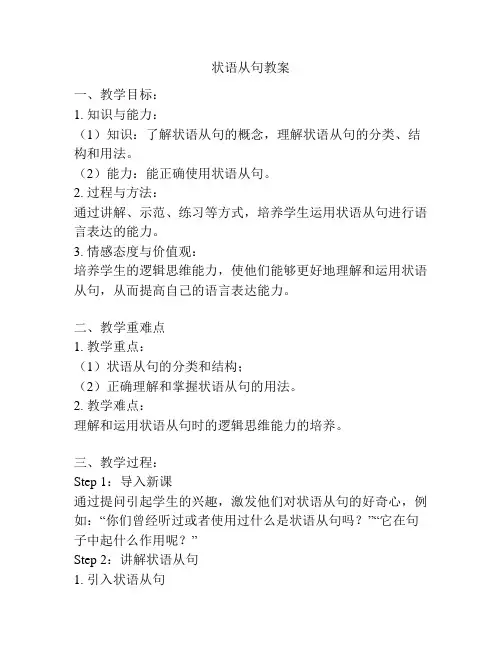
状语从句教案一、教学目标:1. 知识与能力:(1)知识:了解状语从句的概念,理解状语从句的分类、结构和用法。
(2)能力:能正确使用状语从句。
2. 过程与方法:通过讲解、示范、练习等方式,培养学生运用状语从句进行语言表达的能力。
3. 情感态度与价值观:培养学生的逻辑思维能力,使他们能够更好地理解和运用状语从句,从而提高自己的语言表达能力。
二、教学重难点1. 教学重点:(1)状语从句的分类和结构;(2)正确理解和掌握状语从句的用法。
2. 教学难点:理解和运用状语从句时的逻辑思维能力的培养。
三、教学过程:Step 1:导入新课通过提问引起学生的兴趣,激发他们对状语从句的好奇心,例如:“你们曾经听过或者使用过什么是状语从句吗?”“它在句子中起什么作用呢?”Step 2:讲解状语从句1. 引入状语从句通过展示一些句子,引导学生发现句子中的状语从句,并帮助他们理解状语从句的概念。
“如果一个句子中有一个从句,做为该句子的一个成分来修饰主句、表语、动词或形容词等,那么它便是状语从句。
”2. 分类和结构通过示范和解释,教授学生常见的状语从句的分类和结构,如时间状语从句、地点状语从句、方式状语从句、原因状语从句、条件状语从句等,并提供相应的例句进行解释和讨论。
3. 状语从句的使用通过示范和解释,教授学生状语从句的用法,如在复合句中的位置、否定转移、主从句时态的一致性等。
并提供相应的例句进行解释和讨论。
Step 3:练习状语从句1. 配对练习将学生分为小组,让他们根据袋中的状语从句卡片,找到与之对应的主句卡片,并进行连线。
然后每组派一名学生进行讲解。
2. 句子改错将一些句子在黑板上展示出来,让学生找出句子中的错误并修改,确保句子的主谓结构和状语从句的关系的正确性。
3. 完成句子给学生一些提示词,要求他们根据提示词完成句子,并用状语从句表达意思。
Step 4:总结归纳让学生用自己的话总结和归纳状语从句的分类、结构和用法。
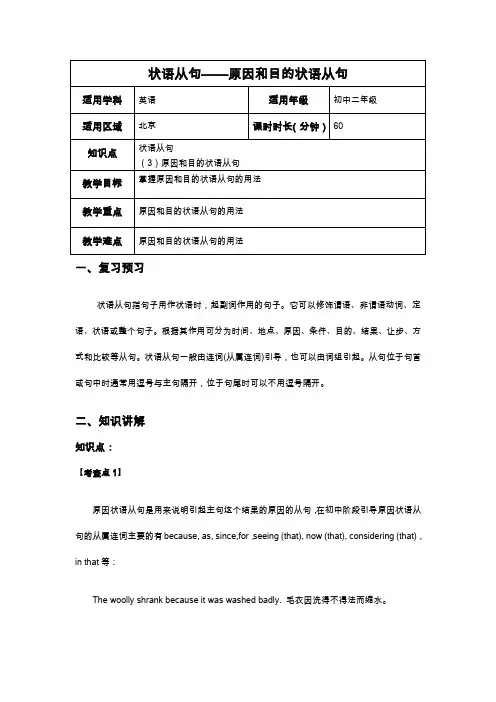
一、复习预习状语从句指句子用作状语时,起副词作用的句子。
它可以修饰谓语、非谓语动词、定语、状语或整个句子。
根据其作用可分为时间、地点、原因、条件、目的、结果、让步、方式和比较等从句。
状语从句一般由连词(从属连词)引导,也可以由词组引起。
从句位于句首或句中时通常用逗号与主句隔开,位于句尾时可以不用逗号隔开。
二、知识讲解知识点:【考查点1】原因状语从句是用来说明引起主句这个结果的原因的从句,在初中阶段引导原因状语从句的从属连词主要的有because, as, since,for,seeing (that), now (that), considering (that),in that等:The woolly shrank because it was washed badly. 毛衣因洗得不得法而缩水。
I can’t get to sleep because of the noise outside. 由于外面声音嘈杂我睡不着。
Since [As] we’ve no money, we can’t buy it. 由于我们没钱,我们无法购买它。
Seeing that it’s raining, we’d better stay indoors. 既然外边在下雨,我们最好待在室内。
Now that you are here, you’d better stay. 你既然来了,最好还是留下吧(既来之,则安之)。
【注】除以上提到的大家比较熟悉的引导原因状语从句的从属连词外,when有时也可引导原因状语从句(when表示“既然”)I won’t tell you when you won’t listen. 既然你不想听,我就不告诉你了。
原因状语从句应注意的问题1、because , since , as , for,辨析1)because语势最强,用来说明人所不知的原因,回答why提出的问题。
当原因是显而易见的或已为人们所知,就用as或since。
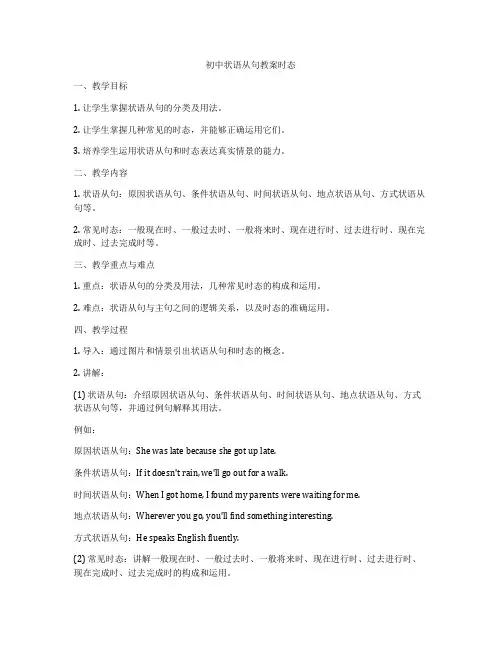
初中状语从句教案时态一、教学目标1. 让学生掌握状语从句的分类及用法。
2. 让学生掌握几种常见的时态,并能够正确运用它们。
3. 培养学生运用状语从句和时态表达真实情景的能力。
二、教学内容1. 状语从句:原因状语从句、条件状语从句、时间状语从句、地点状语从句、方式状语从句等。
2. 常见时态:一般现在时、一般过去时、一般将来时、现在进行时、过去进行时、现在完成时、过去完成时等。
三、教学重点与难点1. 重点:状语从句的分类及用法,几种常见时态的构成和运用。
2. 难点:状语从句与主句之间的逻辑关系,以及时态的准确运用。
四、教学过程1. 导入:通过图片和情景引出状语从句和时态的概念。
2. 讲解:(1) 状语从句:介绍原因状语从句、条件状语从句、时间状语从句、地点状语从句、方式状语从句等,并通过例句解释其用法。
例如:原因状语从句:She was late because she got up late.条件状语从句:If it doesn't rain, we'll go out for a walk.时间状语从句:When I got home, I found my parents were waiting for me.地点状语从句:Wherever you go, you'll find something interesting.方式状语从句:He speaks English fluently.(2) 常见时态:讲解一般现在时、一般过去时、一般将来时、现在进行时、过去进行时、现在完成时、过去完成时的构成和运用。
3. 练习:让学生进行状语从句和时态的练习,巩固所学知识。
4. 拓展:引导学生运用状语从句和时态表达真实情景,提高学生的实际运用能力。
五、教学评价1. 课堂参与度:观察学生在课堂上的积极参与情况和提问回答的表现。
2. 练习完成情况:检查学生完成练习的情况,包括正确性和书写规范性。
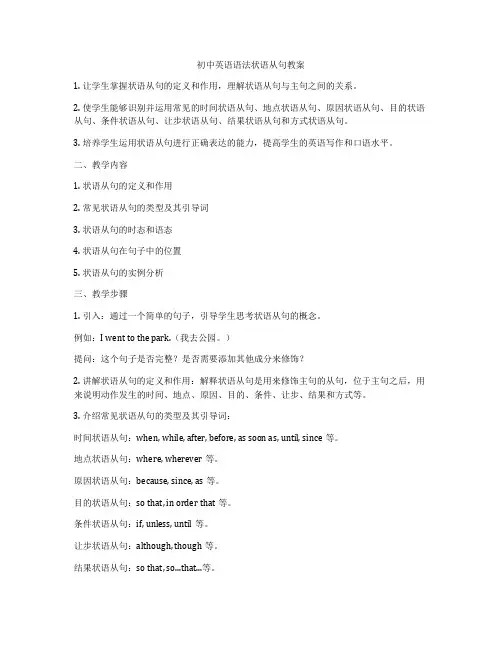
初中英语语法状语从句教案1. 让学生掌握状语从句的定义和作用,理解状语从句与主句之间的关系。
2. 使学生能够识别并运用常见的时间状语从句、地点状语从句、原因状语从句、目的状语从句、条件状语从句、让步状语从句、结果状语从句和方式状语从句。
3. 培养学生运用状语从句进行正确表达的能力,提高学生的英语写作和口语水平。
二、教学内容1. 状语从句的定义和作用2. 常见状语从句的类型及其引导词3. 状语从句的时态和语态4. 状语从句在句子中的位置5. 状语从句的实例分析三、教学步骤1. 引入:通过一个简单的句子,引导学生思考状语从句的概念。
例如:I went to the park.(我去公园。
)提问:这个句子是否完整?是否需要添加其他成分来修饰?2. 讲解状语从句的定义和作用:解释状语从句是用来修饰主句的从句,位于主句之后,用来说明动作发生的时间、地点、原因、目的、条件、让步、结果和方式等。
3. 介绍常见状语从句的类型及其引导词:时间状语从句:when, while, after, before, as soon as, until, since等。
地点状语从句:where, wherever等。
原因状语从句:because, since, as等。
目的状语从句:so that, in order that等。
条件状语从句:if, unless, until等。
让步状语从句:although, though等。
结果状语从句:so that, so...that...等。
方式状语从句:as, as if, as though等。
4. 讲解状语从句的时态和语态:状语从句的时态和语态应与主句保持一致。
5. 讲解状语从句在句子中的位置:状语从句通常位于主句之后,但有时也可以放在主句之前,用逗号与主句分隔。
6. 实例分析:分析一些含有状语从句的句子,让学生明确状语从句的作用和用法。
例如:When I came home, my parents were watching TV.(当我回家时,我的父母正在看电视。
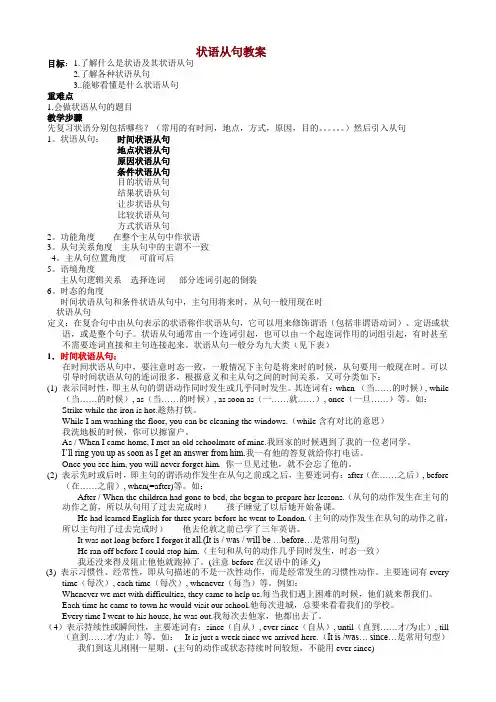
状语从句教案目标:1.了解什么是状语及其状语从句2.了解各种状语从句3..能够看懂是什么状语从句重难点1.会做状语从句的题目教学步骤先复习状语分别包括哪些?(常用的有时间,地点,方式,原因,目的。
)然后引入从句1。
状语从句:时间状语从句地点状语从句原因状语从句条件状语从句目的状语从句结果状语从句让步状语从句比较状语从句方式状语从句2。
功能角度在整个主从句中作状语3。
从句关系角度主从句中的主谓不一致4。
主从句位置角度可前可后5。
语境角度主从句逻辑关系选择连词部分连词引起的倒装6。
时态的角度时间状语从句和条件状语从句中,主句用将来时,从句一般用现在时状语从句定义:在复合句中由从句表示的状语称作状语从句,它可以用来修饰谓语(包括非谓语动词)、定语或状语,或是整个句子。
状语从句通常由一个连词引起,也可以由一个起连词作用的词组引起,有时甚至不需要连词直接和主句连接起来。
状语从句一般分为九大类(见下表)1.时间状语从句:在时间状语从句中,要注意时态一致,一般情况下主句是将来时的时候,从句要用一般现在时。
可以引导时间状语从句的连词很多,根据意义和主从句之间的时间关系,又可分类如下:(1) 表示同时性,即主从句的谓语动作同时发生或几乎同时发生。
其连词有:when (当……的时候), while(当……的时候), as(当……的时候), as soon as(一……就……), once(一旦……)等。
如:Strike while the iron is hot.趁热打铁。
While I am washing the floor, you can be cleaning the windows.(while含有对比的意思)我洗地板的时候,你可以擦窗户。
As / When I came home, I met an old schoolmate of mine.我回家的时候遇到了我的一位老同学。
I’ll ring you up as soon as I get an answer from him.我一有他的答复就给你打电话。
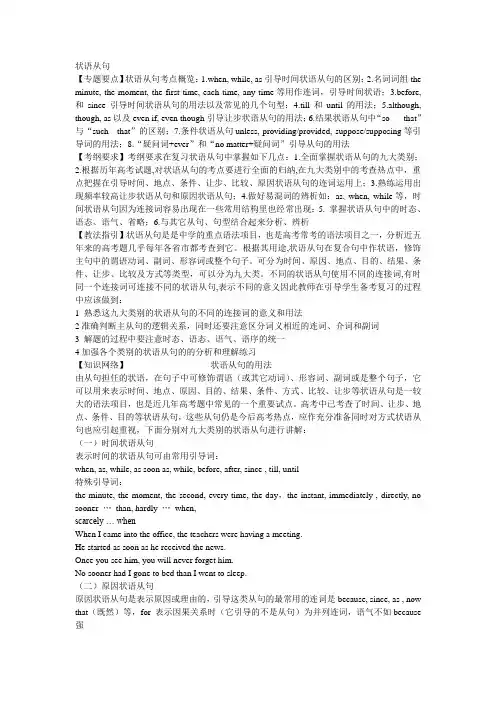
状语从句【专题要点】状语从句考点概览:1.when, while, as引导时间状语从句的区别;2.名词词组the minute, the moment, the first time, each time, any time等用作连词,引导时间状语;3.before,和since引导时间状语从句的用法以及常见的几个句型;4.till和until的用法;5.although, though, as以及even if, even though引导让步状语从句的用法;6.结果状语从句中“so ----that”与“such---that”的区别;7.条件状语从句unless, providing/provided, suppose/supposing等引导词的用法;8.“疑问词+ever”和“no matter+疑问词”引导从句的用法【考纲要求】考纲要求在复习状语从句中掌握如下几点:1.全面掌握状语从句的九大类别;2.根据历年高考试题,对状语从句的考点要进行全面的归纳,在九大类别中的考查热点中,重点把握在引导时间、地点、条件、让步、比较、原因状语从句的连词运用上;3.熟练运用出现频率较高让步状语从句和原因状语从句;4.做好易混词的辨析如:as, when, while等,时间状语从句因为连接词容易出现在一些常用结构里也经常出现;5. 掌握状语从句中的时态、语态、语气、省略;6.与其它从句、句型结合起来分析、辨析【教法指引】状语从句是是中学的重点语法项目,也是高考常考的语法项目之一,分析近五年来的高考题几乎每年各省市都考查到它。
根据其用途,状语从句在复合句中作状语,修饰主句中的谓语动词、副词、形容词或整个句子。
可分为时间、原因、地点、目的、结果、条件、让步、比较及方式等类型,可以分为九大类。
不同的状语从句使用不同的连接词,有时同一个连接词可连接不同的状语从句,表示不同的意义因此教师在引导学生备考复习的过程中应该做到:1 熟悉这九大类别的状语从句的不同的连接词的意义和用法2准确判断主从句的逻辑关系,同时还要注意区分词义相近的连词、介词和副词3 解题的过程中要注意时态、语态、语气、语序的统一4加强各个类别的状语从句的的分析和理解练习【知识网络】状语从句的用法由从句担任的状语,在句子中可修饰谓语(或其它动词)、形容词、副词或是整个句子,它可以用来表示时间、地点、原因、目的、结果、条件、方式、比较、让步等状语从句是一较大的语法项目,也是近几年高考题中常见的一个重要试点。
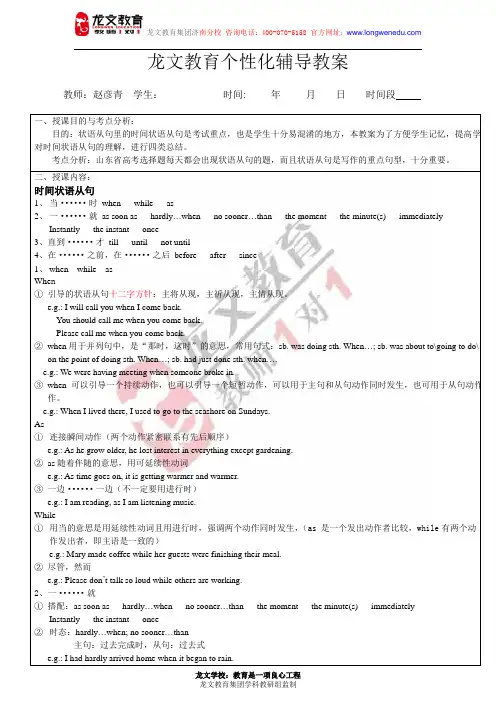
龙文教育个性化辅导教案教师:赵彦青学生:________ 时间:_____年_____月____日时间段一、授课目的与考点分析:目的:状语从句里的时间状语从句是考试重点,也是学生十分易混淆的地方,本教案为了方便学生记忆,提高学生对时间状语从句的理解,进行四类总结。
考点分析:山东省高考选择题每天都会出现状语从句的题,而且状语从句是写作的重点句型,十分重要。
二、授课内容:时间状语从句1、当······时when while as2、一······就as soon as hardly…when no sooner…than the moment the minute(s) immediatelyInstantly the instant once3、直到······才till until not until4、在······之前,在······之后before after since1、when while asWhe n①引导的状语从句十二字方针:主将从现,主祈从现,主情从现。
e.g.: I will call you when I come back.You should call me when you come back.Please call me when you come back.②when用于并列句中,是“那时,这时”的意思,常用句式:sb. was doing sth. When…; sb. was about to\going to do\on the point of doing sth. When…; sb. had just done sth. when….e.g.: We were having meeting when someone broke in.③when可以引导一个持续动作,也可以引导一个短暂动作,可以用于主句和从句动作同时发生,也可用于从句动作先作。
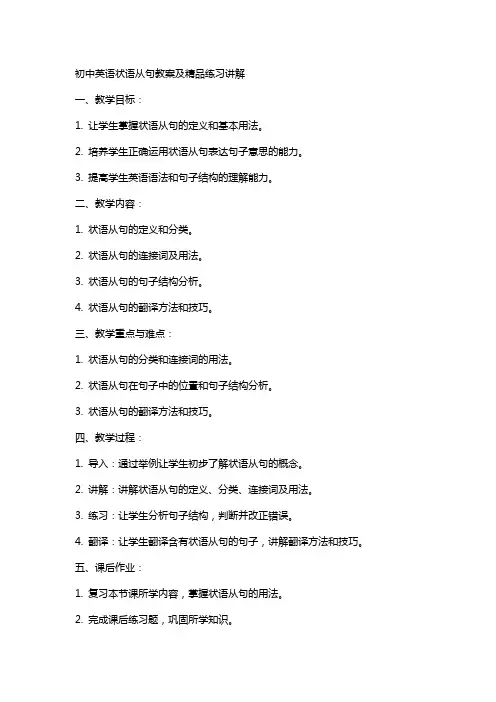
初中英语状语从句教案及精品练习讲解一、教学目标:1. 让学生掌握状语从句的定义和基本用法。
2. 培养学生正确运用状语从句表达句子意思的能力。
3. 提高学生英语语法和句子结构的理解能力。
二、教学内容:1. 状语从句的定义和分类。
2. 状语从句的连接词及用法。
3. 状语从句的句子结构分析。
4. 状语从句的翻译方法和技巧。
三、教学重点与难点:1. 状语从句的分类和连接词的用法。
2. 状语从句在句子中的位置和句子结构分析。
3. 状语从句的翻译方法和技巧。
四、教学过程:1. 导入:通过举例让学生初步了解状语从句的概念。
2. 讲解:讲解状语从句的定义、分类、连接词及用法。
3. 练习:让学生分析句子结构,判断并改正错误。
4. 翻译:让学生翻译含有状语从句的句子,讲解翻译方法和技巧。
五、课后作业:1. 复习本节课所学内容,掌握状语从句的用法。
2. 完成课后练习题,巩固所学知识。
3. 收集含有状语从句的句子,进行翻译和分析。
注意事项:1. 教学过程中要注意举例生动、贴近生活,激发学生的学习兴趣。
2. 针对不同程度的学生,适当调整教学难度,确保教学质量。
3. 注重培养学生的语法分析和运用能力,提高他们的英语水平。
六、教学策略与方法:1. 采用情景教学法,通过设定真实的生活场景,让学生在实际语境中学习和运用状语从句。
2. 使用任务型教学法,设计各种练习任务,让学生在完成任务的过程中掌握状语从句的用法。
3. 采用合作学习法,鼓励学生分组讨论,共同分析句子结构和翻译方法。
4. 运用多媒体教学手段,如PPT、视频等,丰富教学内容,提高学生的学习兴趣。
七、教学评价:1. 课堂表现:观察学生在课堂上的参与程度、发言情况和语法运用准确性。
2. 课后作业:检查学生完成作业的质量,包括语法、句子结构和翻译等方面。
3. 单元测试:定期进行单元测试,评估学生对状语从句知识的掌握程度。
4. 学生互评:鼓励学生相互评价,共同提高英语水平。
八、教学计划:1. 第一周:讲解状语从句的定义和分类。
初中状语从句复习教案一、教学目标:1. 让学生掌握状语从句的种类及用法。
2. 培养学生运用状语从句进行正确表达的能力。
3. 提高学生对英语句型的理解和运用能力。
二、教学内容:1. 状语从句的种类:时间状语从句、地点状语从句、原因状语从句、条件状语从句、方式状语从句、比较状语从句等。
2. 状语从句的连接词:when、where、why、if、unless、as soon as、before、after、until、while、like、than等。
3. 状语从句的句子结构及用法。
三、教学过程:1. 导入:通过一个谜语引导学生复习状语从句。
谜语:什么东西,没有它不行,有了它句子更完整。
让学生猜测,进而引出状语从句的概念。
2. 新课内容展示:(1)时间状语从句:介绍when、while、after、before、until、since等连接词的用法。
(2)地点状语从句:介绍where、near、far from等连接词的用法。
(3)原因状语从句:介绍why、because等连接词的用法。
(4)条件状语从句:介绍if、unless、in case等连接词的用法。
(5)方式状语从句:介绍how、like、as等连接词的用法。
(6)比较状语从句:介绍than、as等连接词的用法。
3. 实例分析:通过具体例句,分析状语从句的用法。
如:(1)When I grow up, I want to be a teacher.(2)While my parents were sleeping, I quietly went out.(3)I didn't go to the party because I was sick.(4)If it doesn't rain tomorrow, we will go hiking.4. 练习环节:设计一些练习题,让学生区分状语从句的种类,并正确运用连接词。
如:(1)选择合适的连接词填空:a. ___ I finish my homework, I will go out to play.b. ___ I arrived home, my mother had already cooked dinner.c. ___ you need help, don't hesitate to ask me.(2)改写句子:a. Tom went to the library. He borrowed a book.b. We waited for an hour. The train finally arrived.5. 总结:对本节课的状语从句进行总结,强调状语从句在句子中的作用和用法。
教案状语从句初中课程目标:1. 学生能够理解状语从句的概念和作用;2. 学生能够识别和运用状语从句的不同类型;3. 学生能够在句子中正确使用状语从句。
教学内容:1. 状语从句的定义和作用;2. 状语从句的类型:地点状语从句、时间状语从句、原因状语从句、条件状语从句等;3. 状语从句的连接词:where、when、why、if、until等。
教学步骤:一、导入(5分钟)1. 引导学生回顾所学过的定语从句和宾语从句,复习其概念和用法;2. 提问:我们已经学习了定语从句和宾语从句,那么有没有同学听说过状语从句呢?什么是状语从句呢?二、新课讲解(15分钟)1. 讲解状语从句的定义和作用:状语从句是用来修饰动词、形容词、副词或整个句子的从句,它起到状语的作用;2. 讲解状语从句的类型:地点状语从句、时间状语从句、原因状语从句、条件状语从句等;3. 讲解状语从句的连接词:where(在哪里)、when(什么时候)、why(为什么)、if (如果)、until(直到)等;4. 举例讲解并让学生跟读不同类型的状语从句。
三、课堂练习(15分钟)1. 让学生分组,每组编写一个含有状语从句的句子,并展示给其他组;2. 让学生互相纠正和评价,教师进行指导和讲解;3. 让学生在小组内互相练习使用状语从句,加强理解和运用。
四、课堂小结(5分钟)1. 教师引导学生总结本节课所学的内容,包括状语从句的定义、类型和连接词等;2. 强调状语从句在句子中的作用和重要性;3. 提醒学生要注意状语从句的使用时机和位置。
五、作业布置(5分钟)1. 让学生回家后编写三个含有不同类型状语从句的句子,并写在作业本上;2. 要求学生在句子中正确使用状语从句,并注意连接词的使用。
教学反思:本节课通过讲解和练习,让学生了解了状语从句的概念、类型和连接词等知识。
在课堂练习环节,学生能够分组编写含有状语从句的句子,并在小组内进行练习和展示。
但在练习过程中,发现部分学生对状语从句的运用还存在一定的困难,需要进一步加强指导和练习。
高中英语《状语从句》教案一、教学目标1. 理解状语从句的定义和作用;2. 分辨不同类型的状语从句,并能正确运用;3. 学会通过状语从句与主句构成复合句。
二、教学重点1. 理解状语从句的定义和作用;2. 分辨不同类型的状语从句,并能正确运用。
三、教学难点1. 学会通过状语从句与主句构成复合句。
四、教学准备1. 教材:教学课本、练习册;2. 多媒体设备。
五、教学过程1. 导入(5分钟)为了引起学生对状语从句的兴趣,教师可以先给学生出几个句子,让他们观察并分析句子结构。
例句:a) While I was studying, my phone rang.b) If it rains tomorrow, we won't go to the park.引导学生思考这些句子中的从句是什么作用,并引导他们尝试理解状语从句的概念。
2. 知识讲解(15分钟)解释状语从句的定义和作用,强调状语从句与主句的关系,并通过几个例句进一步说明。
教师可以按照以下顺序讲解不同类型的状语从句:a) 时间状语从句b) 条件状语从句c) 原因状语从句d) 结果状语从句e) 目的状语从句解释每个类型的状语从句时,可以给出相应的例句,并解释例句中状语从句的用法和意义。
3. 练习与巩固(25分钟)通过练习题帮助学生巩固所学的知识。
例题:1. _______ I was reading a book, the phone rang.a) Ifb) Whilec) Becaused) So2. We won't go to the park _______ it rains.a) whenb) ifc) becaused) so让学生独立完成练习题,并检查答案,解释正确答案的原因。
4. 拓展与应用(15分钟)通过提供更复杂的句子和情境,让学生在实际应用中运用状语从句。
例句:a) If I have time, I will visit my grandparents this weekend.b) Unless you apologize, I won't forgive you.教师可以组织学生分组讨论、编写对话或者写作,要求他们使用状语从句构成复杂句。
高三英语语法专题复习之状语从句教材内容分析本课是进行高三英语语法的复习,我在教学中将语法知识的传授和语言基本技能的学习结合到一起,注重复习语法与语言的运用。
采用任务型教学法和小组合作探究学习法,从而扩大课堂的语言输入量及学生的语言输出量。
教学目标1、知识与技能引导学生准确把握非状语从句的使用。
根据该语法规律解决实际问题。
在运用语言的过程中培养学生的观察力、分析力、想象力和自学能力,帮助学生加强记忆力,提高思维能力和运用英语的综合能力,激发创造能力。
2、过程与方法以学生为主体,尝试创新思维,联系社会采用讨论、协作、探究、竞争的教学模式,引导学生灵活运用所学语法知识3、情感、态度的价值观。
用状语从句的句子结构表达思想感情和正确的世界观、人生观。
形成健全的情感态度,为未来发展和终身学习奠定好的基础。
教学重难点1)教学重点:了解和掌握状语从句的使用。
2)教学难点:能够运用此语法规则完成各种练习训练,并在实际语言活动中灵活运用。
一.状语从句的定义:在复合句中由从句表示的状语称作状语从句,它可以用来修饰谓语(包括非谓语动词)、定语或状语,或是整个句子。
状语从句通常由一个连词引起,也可以由一个起连词作用的词组引起,有时甚至不需要连词直接和主句连接起来。
状语从句一般分为九大类时间状语从句地点状语从句原因状语从句目的状语从句结果状语从句条件状语从句方式状语从句比较状语从句让步状语从句二.状语从句的分类:1.时间状语从句:在时间状语从句中,要注意时态一致,一般情况下主句是将来时的时候,从句要用一般现在时。
可以引导时间状语从句的连词很多,根据意义和主从句之间的时间关系,又可分类如下:(1)表示同时性,即主从句的谓语动作同时发生或几乎同时发生。
其连词有:when (当……的时候), while(当……的时候), as(当……的时候), once(一旦……)as soon as(一……就……), the time(当……的时刻), the moment(当……的时刻), by the time(到……时候为止), next time(下次), the first time(第一次……的时候), the last time(上次……的时候),immediately(一……就……), instantly(一……就……),directly(一……就……)以下关联词引起的句子中,前面常用过去完成时,后面用一般过去时hardly /scarcely…when…(刚……就……), no sooner…than…(刚……就……)Strike while the iron is hot.趁热打铁。
状语从句教案教案标题:状语从句教案一、教学目标:1. 知识目标:学生能够理解和区分状语从句及其分类,并掌握它们在句子中的正确用法。
2. 能力目标:学生能够正确运用状语从句来丰富和改变句子的意思。
3. 情感目标:通过学习状语从句,培养学生对语法知识的兴趣,提高他们的语言表达能力。
二、教学重点:1. 理解和分辨状语从句及其分类。
2. 掌握状语从句的常见引导词和句型。
3. 运用状语从句来改变句子结构和运用范围。
三、教学难点:1. 区分状语从句的不同类型。
2. 理解状语从句与主句的逻辑关系。
四、教学方法:1. 提问法:通过提问,引导学生思考状语从句的不同种类及其用法。
2. 归纳法:通过让学生总结规律,形成对状语从句的整体概念。
3. 练习法:通过一些练习题帮助学生巩固状语从句的使用。
五、教学过程:1. 导入:通过提问复习学生对从属连词的理解,例如:“when”和“where”这样的词在句子中有什么作用?2. 呈现:向学生介绍状语从句的定义和作用,以及主要的引导词,如:"when","where","if"等。
3. 教学:详细讲解不同类型的状语从句,并分别给出例句和解释,如时间状语从句、地点状语从句、条件状语从句等。
4. 练习:让学生根据给定的句子,判断下划线部分是哪种类型的状语从句,并改写句子,如:"I will call you when I arrive home." → "When I arrive home, I will call you."5. 巩固:让学生在小组中进行练习,编写句子包含状语从句,并与同伴分享。
6. 拓展:给学生一些拓展练习,包括使用不同类型的状语从句来改写句子或填空练习。
7. 总结:让学生总结本堂课所学内容,包括状语从句的定义、特点、分类和使用方法。
8. 作业:布置相关的练习题,巩固学生对状语从句的理解和运用。
原因状语从句(教案)章节一:引言教学目标:1. 让学生了解原因状语从句的概念和作用。
2. 培养学生对原因状语从句的兴趣和好奇心。
教学内容:1. 介绍原因状语从句的定义和用法。
2. 举例说明原因状语从句在句子中的作用。
教学步骤:1. 引入话题:询问学生对状语从句的了解。
2. 讲解原因状语从句的定义和用法。
3. 举例说明原因状语从句在句子中的作用。
4. 让学生练习使用原因状语从句。
教学评估:1. 观察学生在练习中的表现,了解他们对原因状语从句的理解程度。
2. 鼓励学生提出问题和疑问,及时解答。
章节二:基本用法教学目标:1. 让学生掌握原因状语从句的基本用法。
2. 培养学生正确使用原因状语从句的能力。
教学内容:1. 讲解原因状语从句的基本用法。
2. 举例说明原因状语从句在句子中的作用。
教学步骤:1. 回顾上一节课的内容,加深学生对原因状语从句的理解。
2. 讲解原因状语从句的基本用法。
3. 举例说明原因状语从句在句子中的作用。
4. 让学生进行练习,巩固所学内容。
教学评估:1. 观察学生在练习中的表现,了解他们对原因状语从句的掌握程度。
2. 鼓励学生提出问题和疑问,及时解答。
章节三:常用连词教学目标:1. 让学生熟悉并掌握原因状语从句中常用的连词。
2. 培养学生正确使用原因状语从句的能力。
教学内容:1. 介绍原因状语从句中常用的连词。
2. 举例说明常用连词在原因状语从句中的使用。
教学步骤:1. 回顾上一节课的内容,加深学生对原因状语从句的理解。
2. 介绍原因状语从句中常用的连词。
3. 举例说明常用连词在原因状语从句中的使用。
4. 让学生进行练习,巩固所学内容。
教学评估:1. 观察学生在练习中的表现,了解他们对常用连词的掌握程度。
2. 鼓励学生提出问题和疑问,及时解答。
章节四:实践应用教学目标:1. 让学生能够熟练运用原因状语从句进行表达。
2. 培养学生的实际应用能力。
教学内容:1. 讲解如何运用原因状语从句进行表达。
状语从句复习学教案➢考点揭密在复合句中修饰主句中的动词、形容词或副词,起状语作用的从句叫状语从句。
状语从句可置主语之前,也可置主语之后。
前置时,从句后用逗号与主句分开;后置时,与主句之间无标点符号。
状语从句可分为时间、原因、目的、结果、条件、比较、地点、让步、方式等九类。
中考考点设置1.时间状语从句(1)引导词:when,while,as,before,after, as soon as,until,since.(2)主句为将来时,从句用一般现在时代替。
(3)not...until的同义句替换。
*(4)when和while在过去将来时中的用法典型例题解析例1.---I hope you’ll enjoy your trip, dear!---Thank you, mum. I’ll give you a call _________ I get there.A. untilB. as soon asC. sinceD. till答案:B。
该题考查的是引导状语从句的从属连词的选择。
本题的意思是“一到那里,我就给你打电话。
”要表达这个意思应选用as soon as。
例2. None of us knew what had happened _________ they told us about it.A. whenB. untilC. afterD. though答案:B。
该题考查的是引导状语从句的从属连词选择。
本句的意思是“在……以前我们没人知道这件事。
”要表达着一意思应用“not…until” 这一句型。
例3.I’m sure. He will jump when he _________the good news.A. learn aboutB.will learn aboutC.learning aboutD.learns about答案:D。
时间状语从句中,逐句若是一般将来时,从句应用一般现在表示将来时的意思。
例4.The children _________a P.E. class on the playground when it suddenly began to rain.A.haveB. are havingC. hadD. were having答案:DWhen引导的从句时过去时态,说明在过去的时间里孩子们正在上体育课。
因此句子时进行时。
中考真题精选1.I was watching the charitu show on TV _________the telephone rang.A. whenB. whileC. as soon as D,until2.Jim was reading _________his sister was writing.A. when B while C before D. after3.Peter likes reading a newpaper _________he is having brekfast.A. whenB. untilC. bacauseD. though4.The earthquake happened _________ all the people were sleeping.A. whenB. whileC.as soon asD. before5.You should finish your lessons _______ you go out to paly.A. beforeB. afterC. whenD. while6Lucy knew nothing about it _________her sister told her.[2003 河北省]A.becauseB.untilC.ifD.since2.条件状语从句(1)引导词:if,unless.as long as (只要…就…)(2)主句为将来时,从句用一般现在时代替。
(3)if...not与unless及or的同义句转换。
典型例题解析例1. You will stay healthy _______ you do more exercise, such as running and walking.A. ifB. howC. beforeD. where答案:A。
该题考查的是引导状语从句的从属连词的选择。
从意思上看,从句应是一个条件状语从句,在这四个选项中只有if能引导条件状语从句,所以选A。
例2. If I find his phone number, I _______you.A.tellB. toldC. will tellD. have told答案:C.本体考察的是If 引导的条件状语从句,如果我找到他的电话号码,我就告诉你,在条件状语从句中,主句用一般将来时,从句用一般现在时表示将来时的意思例3----May I go to the concert with you?----I’m afraid not ______you have a ticket,because I have only one.A.sinceB. ifC. unlessD. though答案C 由题意得知,我只有一张票如果你想和我一起去,除非你有一张票。
Since意为因为,If意为如果,unless 意为除非though 意为尽管,所以选C中考真题精选1. ---Jason wants to know if _________a school sports meeting tomorrow?----Yes, we will. But if it _________,we’ll habe classes instead.A.will you have, rainsB.you will have, rainsC. you will have , rainsD.will you have,will rain2. ---Do you know if he _______ to play basket ball with us?---I think he will come if he ______ free tomorrow.A. comes; isB. comes; will beC. will come; isD. will come; will be3The flowers_________well if they_________.A.won't grow,don't take good care ofB.don't grow,are taken good care ofC.don't grow,don't take good care ofD.won't grow,are not taken good care of4..A tourist will easily lose his way in Beijing________he has a map pr a guide.A. ifB. becauseC. unlessD. when3.原因状语从句(1)引导词:because, since, as.(2)对because 原因状语提问用“why”。
(3)because 不能与so 连用。
(4)because,since,as,for 的区别:because 从句所表示的是对方不知道的直接的原因,因此在回答以why引导的特殊疑问句时只可用because,而as,since 引导的从句却不可;as,since从句所表示的往往是对方已知的原因;for往往用于附加理由证明。
典型例题解析例1 He missed the train this moring________hre got up late.A. orB. ifC. butD. because答案:________此题考察状语从句连词,只要明白预警,分清选项中四个连词所表达的含义,就能正确选出答案,or 有“或者”和“否则”两个意思;if是“如果”的意思;but表示转折关系,意思是“但是”because表示因果关系,所以应选because中考真题精选1. .Because his mother was ill,_________he must stay at home to look after her.A./B.soC.thatD.either2. .—Why are you late for school?—_________ I got up late.A.BecauseB.ForC.SinceD.As3. He took off his coat _______ he felt hot. A. because B. as C. if D. since4.---Is everyone here today? ---No, Tom is at home_________he had a bad cold.A. bacause D. though C.if D. unless4.目的状语和结果状语(1)目的状语从句引导词:so that. in order that 从句中常用情态动词。
★so that既可引导目的状语从句,又可引导结果状语从句。
区别这两种从句的办法有两个:1)目的状语从句里往往带有情态动词can, could, may, mightwould等。
2)从意思上看,目的状语从句往往表示的目的很明确。
例如:Speak clearly so that they may understand you. (目的状语从句)Jack is badly ill so that he has to rest. (结果状语从句)(2)结果状语从句引导词:so...that,such...that.(3)so与such 的区别①so+形+a/an+名such+a/an+形+名②so+many/much/few/little+形+名如果名词前由many, much, little, few等词修饰时,只能用so, 不用such。
例如:Soon there were so many deer that they ate up all the wild roses.He has so little time that he can’t go to the cinema with you.③such+形+不可数名词/可数名词复数(4)so...that与too...to和...enough to间转换典型例题解析例1.---Sam, you look tired today,what’s the matter ?----I was _______busy _______I didn’t go to bed until midnight yesterday.A,too to B. so that C. so to D. such that答案_______ 此题答语意为“我太忙了以至于昨天知道半夜才睡觉”是一个结果状语从句。